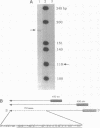Abstract
We report the structure of the human annexin VI gene and compare the intron-exon organization with the known structures of the human annexin I and II genes. The gene is approximately 60 kbp long and contains 26 exons. Consistent with the published annexin VI cDNA sequence, the genomic sequence at the 3' end does not contain a canonical polyadenylation signal. The genomic sequence upstream of the transcription start site contains TATAA and CAAT motifs. The spatial organization of the exons does not reveal any obvious similarities between the two halves of the annexin VI gene. Comparison of the intron-exon boundary positions of the annexin VI gene with those of annexins I and II reveals that within the repeated domains the break points are perfectly conserved except for exon 8, which is one codon smaller in annexin II. The corresponding point in the second half of annexin VI is represented by two exons, exons 20 and 21. The latter exon is alternatively spliced, giving rise to two annexin VI isoforms that differ with respect to a 6-amino acid insertion at the start of repeat 7.
Full text
PDF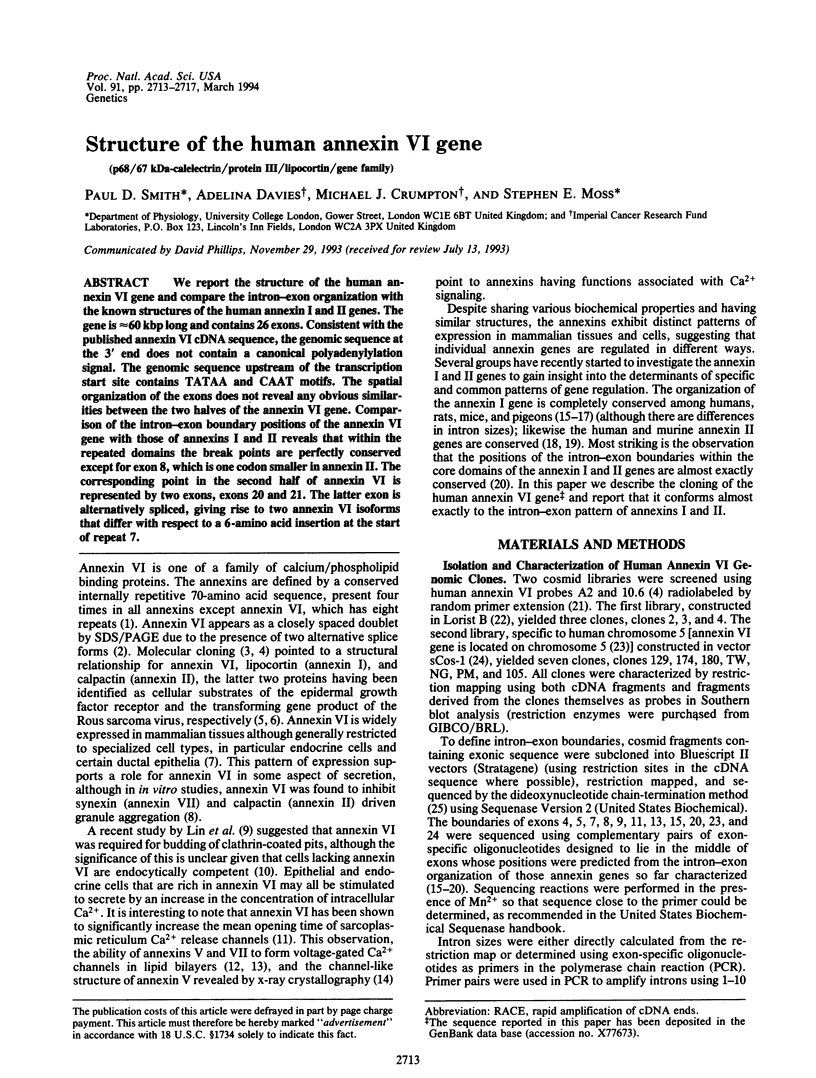
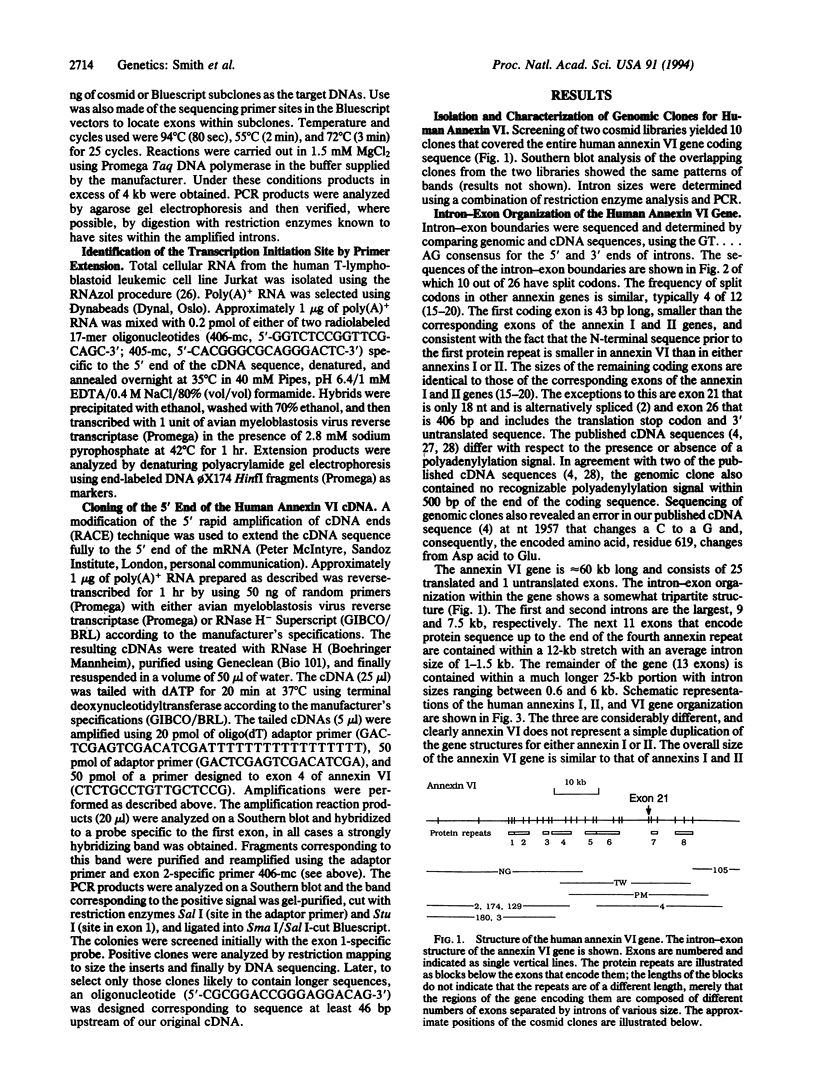
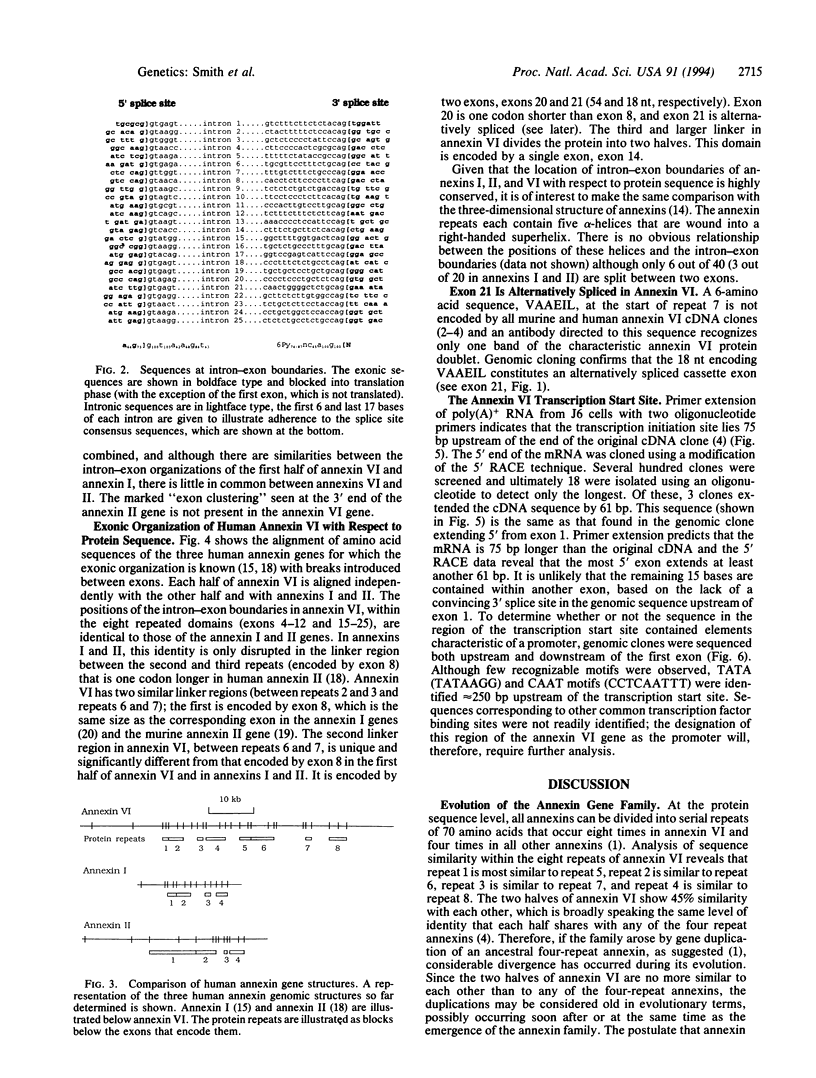
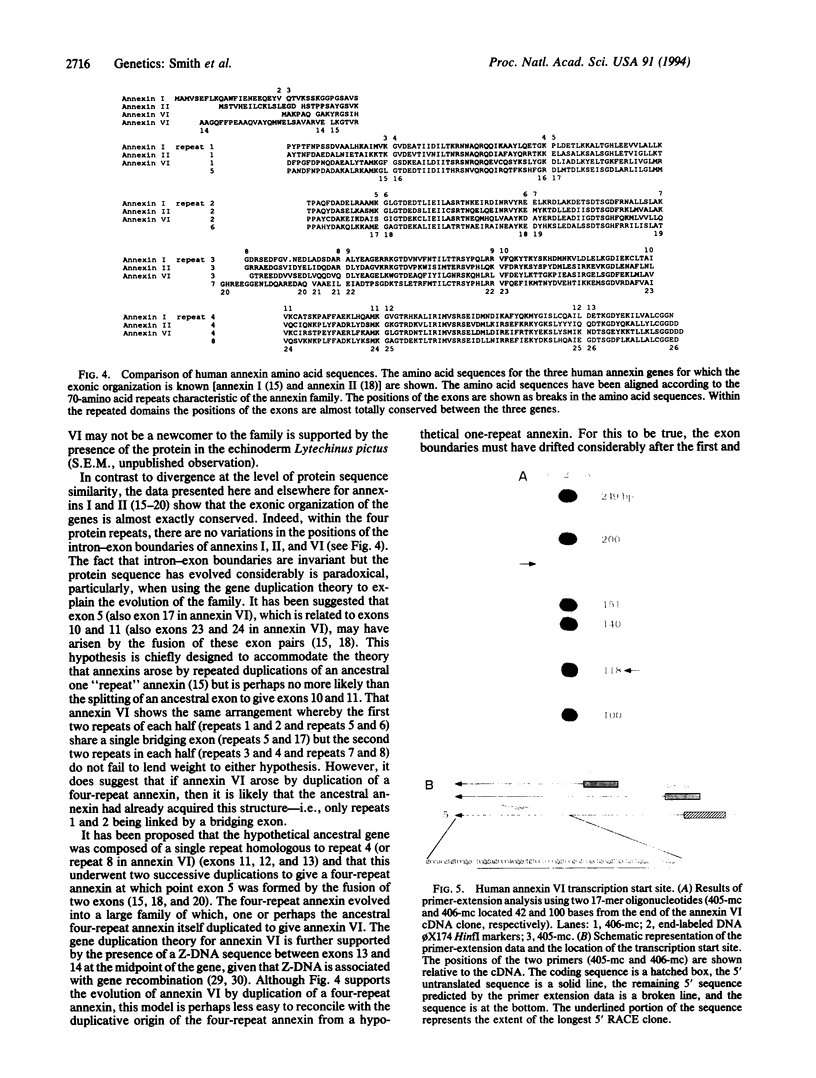
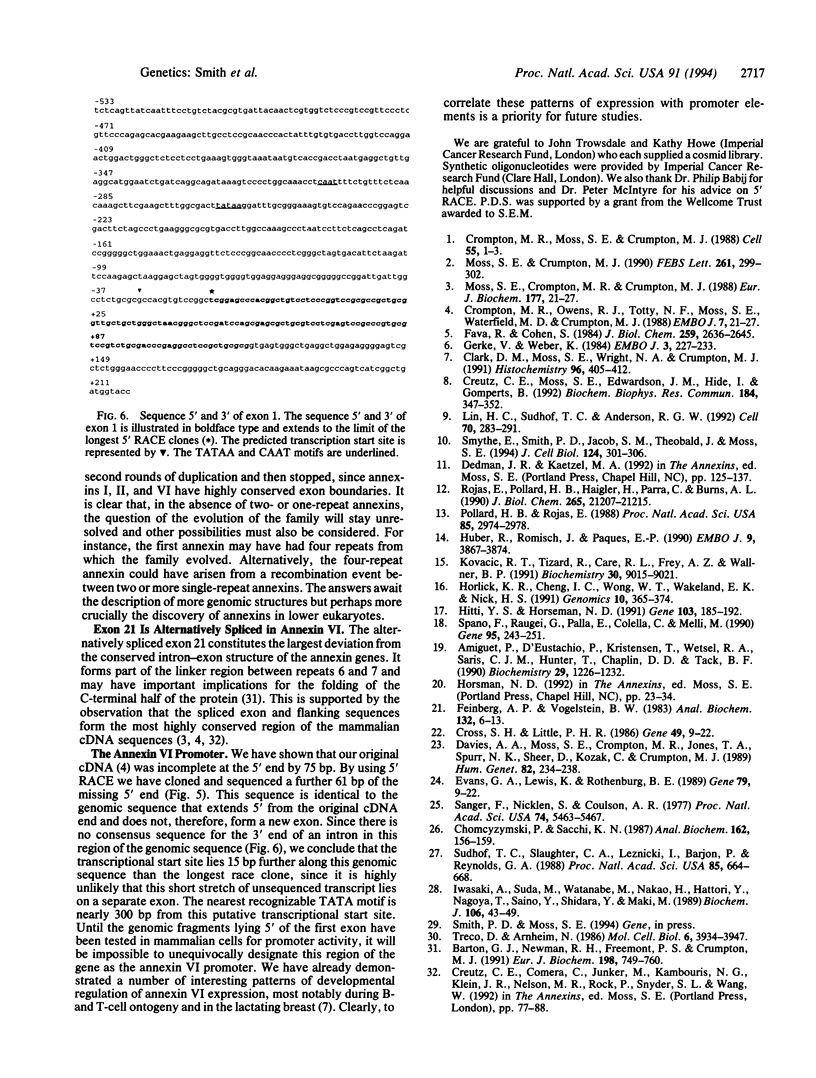
Images in this article
Selected References
These references are in PubMed. This may not be the complete list of references from this article.
- Amiguet P., D'Eustachio P., Kristensen T., Wetsel R. A., Saris C. J., Hunter T., Chaplin D. D., Tack B. F. Structure and chromosome assignment of the murine p36 (calpactin I heavy chain) gene. Biochemistry. 1990 Feb 6;29(5):1226–1232. doi: 10.1021/bi00457a019. [DOI] [PubMed] [Google Scholar]
- Barton G. J., Newman R. H., Freemont P. S., Crumpton M. J. Amino acid sequence analysis of the annexin super-gene family of proteins. Eur J Biochem. 1991 Jun 15;198(3):749–760. doi: 10.1111/j.1432-1033.1991.tb16076.x. [DOI] [PubMed] [Google Scholar]
- Chomczynski P., Sacchi N. Single-step method of RNA isolation by acid guanidinium thiocyanate-phenol-chloroform extraction. Anal Biochem. 1987 Apr;162(1):156–159. doi: 10.1006/abio.1987.9999. [DOI] [PubMed] [Google Scholar]
- Clark D. M., Moss S. E., Wright N. A., Crumpton M. J. Expression of annexin VI (p68, 67 kDa-calelectrin) in normal human tissues: evidence for developmental regulation in B- and T-lymphocytes. Histochemistry. 1991;96(5):405–412. doi: 10.1007/BF00315998. [DOI] [PubMed] [Google Scholar]
- Creutz C. E., Moss S., Edwardson J. M., Hide I., Gomperts B. Differential recognition of secretory vesicles by annexins. European Molecular Biology Organization Course "Advanced Techniques for Studying Secretion". Biochem Biophys Res Commun. 1992 Apr 15;184(1):347–352. doi: 10.1016/0006-291x(92)91199-z. [DOI] [PubMed] [Google Scholar]
- Crompton M. R., Moss S. E., Crumpton M. J. Diversity in the lipocortin/calpactin family. Cell. 1988 Oct 7;55(1):1–3. doi: 10.1016/0092-8674(88)90002-5. [DOI] [PubMed] [Google Scholar]
- Crompton M. R., Owens R. J., Totty N. F., Moss S. E., Waterfield M. D., Crumpton M. J. Primary structure of the human, membrane-associated Ca2+-binding protein p68 a novel member of a protein family. EMBO J. 1988 Jan;7(1):21–27. doi: 10.1002/j.1460-2075.1988.tb02779.x. [DOI] [PMC free article] [PubMed] [Google Scholar]
- Cross S. H., Little P. F. A cosmid vector for systematic chromosome walking. Gene. 1986;49(1):9–22. doi: 10.1016/0378-1119(86)90381-1. [DOI] [PubMed] [Google Scholar]
- Davies A. A., Moss S. E., Crompton M. R., Jones T. A., Spurr N. K., Sheer D., Kozak C., Crumpton M. J. The gene coding for the p68 calcium-binding protein is localised to bands q32-q34 of human chromosome 5, and to mouse chromosome 11. Hum Genet. 1989 Jun;82(3):234–238. doi: 10.1007/BF00291161. [DOI] [PubMed] [Google Scholar]
- Evans G. A., Lewis K., Rothenberg B. E. High efficiency vectors for cosmid microcloning and genomic analysis. Gene. 1989 Jun 30;79(1):9–20. doi: 10.1016/0378-1119(89)90088-7. [DOI] [PubMed] [Google Scholar]
- Fava R. A., Cohen S. Isolation of a calcium-dependent 35-kilodalton substrate for the epidermal growth factor receptor/kinase from A-431 cells. J Biol Chem. 1984 Feb 25;259(4):2636–2645. [PubMed] [Google Scholar]
- Feinberg A. P., Vogelstein B. A technique for radiolabeling DNA restriction endonuclease fragments to high specific activity. Anal Biochem. 1983 Jul 1;132(1):6–13. doi: 10.1016/0003-2697(83)90418-9. [DOI] [PubMed] [Google Scholar]
- Gerke V., Weber K. Identity of p36K phosphorylated upon Rous sarcoma virus transformation with a protein purified from brush borders; calcium-dependent binding to non-erythroid spectrin and F-actin. EMBO J. 1984 Jan;3(1):227–233. doi: 10.1002/j.1460-2075.1984.tb01789.x. [DOI] [PMC free article] [PubMed] [Google Scholar]
- Hitti Y. S., Horseman N. D. Structure of the gene encoding columbid annexin Icp35. Gene. 1991 Jul 22;103(2):185–192. doi: 10.1016/0378-1119(91)90272-d. [DOI] [PubMed] [Google Scholar]
- Horlick K. R., Cheng I. C., Wong W. T., Wakeland E. K., Nick H. S. Mouse lipocortin I gene structure and chromosomal assignment: gene duplication and the origins of a gene family. Genomics. 1991 Jun;10(2):365–374. doi: 10.1016/0888-7543(91)90321-5. [DOI] [PubMed] [Google Scholar]
- Huber R., Römisch J., Paques E. P. The crystal and molecular structure of human annexin V, an anticoagulant protein that binds to calcium and membranes. EMBO J. 1990 Dec;9(12):3867–3874. doi: 10.1002/j.1460-2075.1990.tb07605.x. [DOI] [PMC free article] [PubMed] [Google Scholar]
- Iwasaki A., Suda M., Watanabe M., Nakao H., Hattori Y., Nagoya T., Saino Y., Shidara Y., Maki M. Structure and expression of cDNA for calphobindin II, a human placental coagulation inhibitor. J Biochem. 1989 Jul;106(1):43–49. doi: 10.1093/oxfordjournals.jbchem.a122816. [DOI] [PubMed] [Google Scholar]
- Kovacic R. T., Tizard R., Cate R. L., Frey A. Z., Wallner B. P. Correlation of gene and protein structure of rat and human lipocortin I. Biochemistry. 1991 Sep 17;30(37):9015–9021. doi: 10.1021/bi00101a015. [DOI] [PubMed] [Google Scholar]
- Lin H. C., Südhof T. C., Anderson R. G. Annexin VI is required for budding of clathrin-coated pits. Cell. 1992 Jul 24;70(2):283–291. doi: 10.1016/0092-8674(92)90102-i. [DOI] [PubMed] [Google Scholar]
- Moss S. E., Crompton M. R., Crumpton M. J. Molecular cloning of murine p68, a Ca2+-binding protein of the lipocortin family. Eur J Biochem. 1988 Oct 15;177(1):21–27. doi: 10.1111/j.1432-1033.1988.tb14340.x. [DOI] [PubMed] [Google Scholar]
- Moss S. E., Crumpton M. J. Alternative splicing gives rise to two forms of the p68 Ca2(+)-binding protein. FEBS Lett. 1990 Feb 26;261(2):299–302. doi: 10.1016/0014-5793(90)80576-5. [DOI] [PubMed] [Google Scholar]
- Pollard H. B., Rojas E. Ca2+-activated synexin forms highly selective, voltage-gated Ca2+ channels in phosphatidylserine bilayer membranes. Proc Natl Acad Sci U S A. 1988 May;85(9):2974–2978. doi: 10.1073/pnas.85.9.2974. [DOI] [PMC free article] [PubMed] [Google Scholar]
- Rojas E., Pollard H. B., Haigler H. T., Parra C., Burns A. L. Calcium-activated endonexin II forms calcium channels across acidic phospholipid bilayer membranes. J Biol Chem. 1990 Dec 5;265(34):21207–21215. [PubMed] [Google Scholar]
- Sanger F., Nicklen S., Coulson A. R. DNA sequencing with chain-terminating inhibitors. Proc Natl Acad Sci U S A. 1977 Dec;74(12):5463–5467. doi: 10.1073/pnas.74.12.5463. [DOI] [PMC free article] [PubMed] [Google Scholar]
- Smythe E., Smith P. D., Jacob S. M., Theobald J., Moss S. E. Endocytosis occurs independently of annexin VI in human A431 cells. J Cell Biol. 1994 Feb;124(3):301–306. doi: 10.1083/jcb.124.3.301. [DOI] [PMC free article] [PubMed] [Google Scholar]
- Spano F., Raugei G., Palla E., Colella C., Melli M. Characterization of the human lipocortin-2-encoding multigene family: its structure suggests the existence of a short amino acid unit undergoing duplication. Gene. 1990 Nov 15;95(2):243–251. doi: 10.1016/0378-1119(90)90367-z. [DOI] [PubMed] [Google Scholar]
- Südhof T. C., Slaughter C. A., Leznicki I., Barjon P., Reynolds G. A. Human 67-kDa calelectrin contains a duplication of four repeats found in 35-kDa lipocortins. Proc Natl Acad Sci U S A. 1988 Feb;85(3):664–668. doi: 10.1073/pnas.85.3.664. [DOI] [PMC free article] [PubMed] [Google Scholar]
- Treco D., Arnheim N. The evolutionarily conserved repetitive sequence d(TG.AC)n promotes reciprocal exchange and generates unusual recombinant tetrads during yeast meiosis. Mol Cell Biol. 1986 Nov;6(11):3934–3947. doi: 10.1128/mcb.6.11.3934. [DOI] [PMC free article] [PubMed] [Google Scholar]



